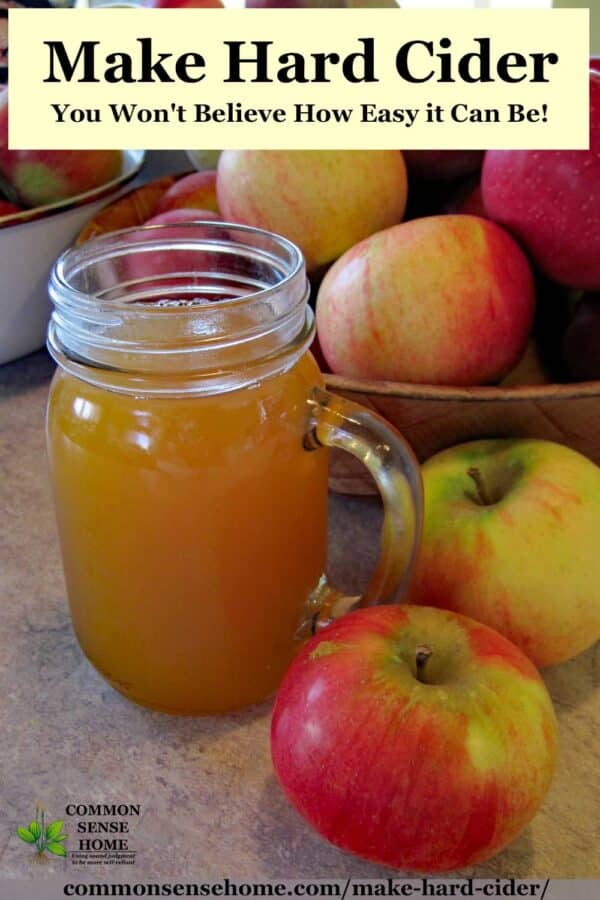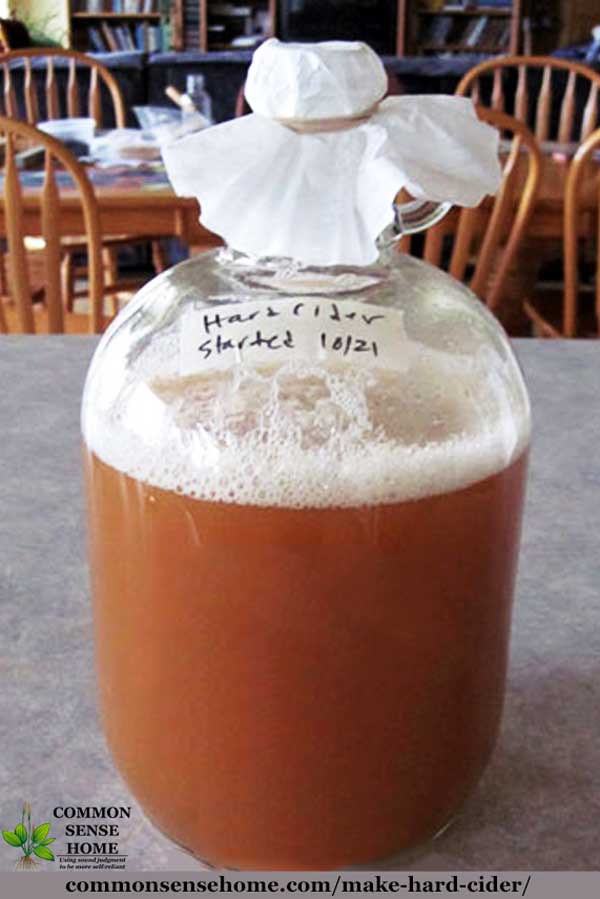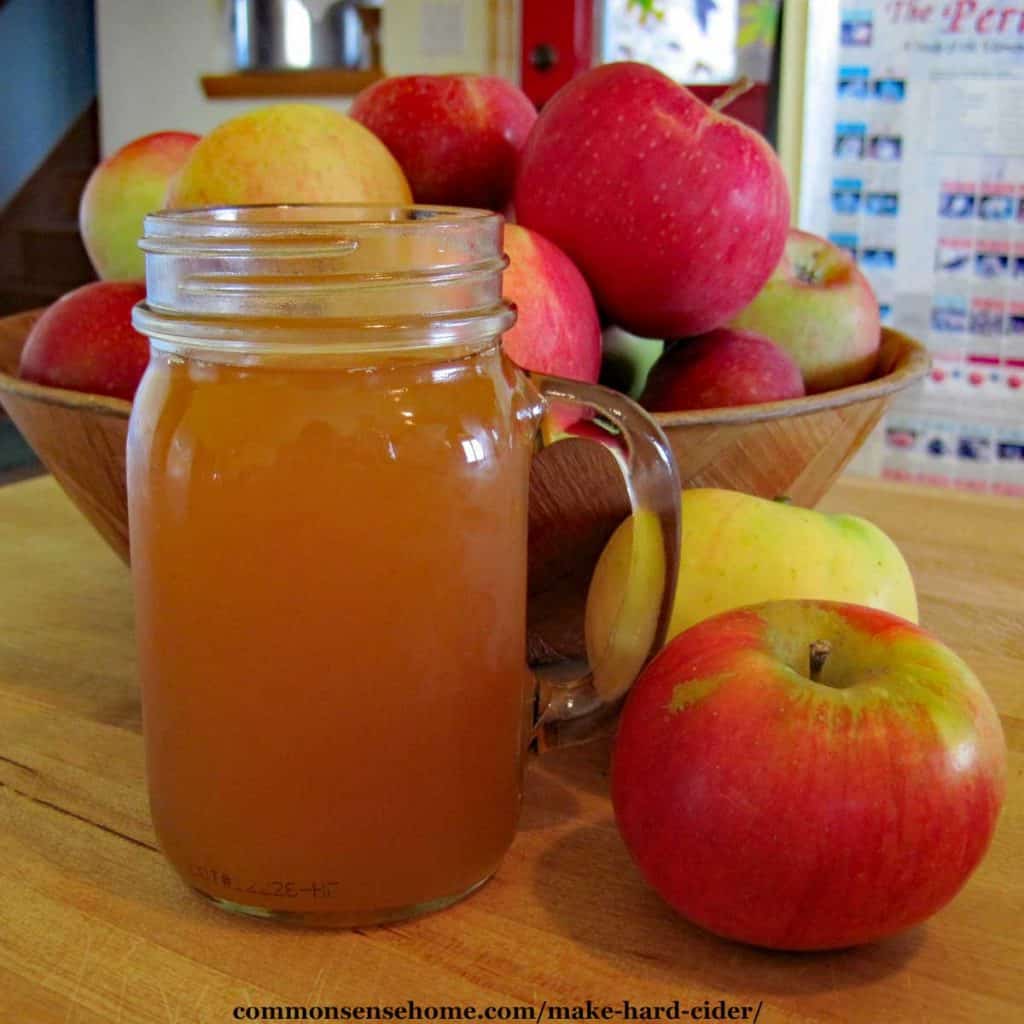How Much Stevia Liquid to Back Sweeten 6 Gallons Hard Cider
This post may contain affiliate links which won't change your price but will share some commission.

Making homemade hard cider doesn't have to be complicated. With these easy recipes, you'll can enjoy the benefits of the brew from your own kitchen. Cider is naturally high in vitamin C and antioxidants, and is a great addition to any gathering.

The simplest recipe is ready in just a few days. For long term storage, you need a bit more equipment, time and patience, but it's still a fairly straightforward process. In this post, we'll share three ways to make hard apple cider. (You can check the comments for tips on making apple jack, which is considerably stronger.)
Contents
- What is Hard Cider?
- Make Sure to Start with the Right Apple Juice or Sweet Cider
- How to Make Hard Cider – The Easy Way
- Ingredients
- Directions
- Traditional Farmhouse Cider
- Ingredients
- Directions
- Cidermaking Tips
What is Hard Cider?
Hard apple cider is simply sweet (nonalcoholic) apple cider that's been fermented to make it an alcoholic beverage.
In the United States, back in colonial times, most apples were pressed into cider. Since there was no refrigeration, the only fresh apple cider came right off the press. The rest was served fermented, or "hard".
The book Wild Fermentation notes that in Massachusetts in 1767, annual hard cider consumption was greater than 35 gallons per person. Given that alcohol is a natural preservative, inhibiting microbe growth, in many cases the stored fermented juice was likely safer than the drinking water.
Make Sure to Start with the Right Apple Juice or Sweet Cider
All you need to be a cider maker is apples or raw, sweet apple juice. The first two simple recipes use the naturally occurring wild yeasts found on the apples and in the air to do the fermenting. There is a risk that you could go past alcohol to vinegar, but I've had good results.
Make sure to read the fine print on purchased products. Preservatives and pasteurization will inhibit fermentation. The heavy duty preservatives used to keep products shelf stable will kill even commercial yeast. Do not use sweet apple cider or juice with chemical preservatives such as Potassium Sorbate, Sodium Benzoate, etc – they will not ferment.
UV treated sweet cider will work for fermenting. Blends with vitamin C added are also acceptable.
Can't find raw apple juice with no additives? Go ahead and use your juicer, or if you want to ramp up production, buy or make your own cider press.
The book "Anyone Can Build A Whizbang Apple Grinder & Cider Press" by Herrick C. Kimball walks you through building a press step by step. I think Herrick can build just about anything, and makes it easy for others to build, too. (He's the same fellow who came up with the WhizBang Chicken Plucker and he wrote The Planet Whizbang Idea Book for Gardeners.)
Use apples that are clean and unspoiled – rot spots will spoil your ferment. Ugly apples are fine, and may even have more pronounced flavors that picture perfect apples. It's great to use a mix of apple varieties, so you get a nice balance of tart and sweet.
How to Make Hard Cider – The Easy Way
Adapted from Spontaneous Cider in Wild Fermentation
Ingredients
1 gallon unpasteurized, preservative free fresh apple cider or apple juice
Directions
You can ferment in a plastic jug, but I highly recommend transferring your fresh cider to a glass gallon jug or carboy. Pour off about a pint of liquid so there is room for the bubbles of fermentation. Cover the top of your container with a coffee filter or other material that will breathe enough to allow wild yeast in, but with a fine enough mesh to keep fruit flies out. Keep out of direct sunlight. (I keep mine on the kitchen counter and cover with a flour sack towel.)

Leave your gallon of cider to ferment at room temperature for two days, and then start tasting at frequent intervals. When it reaches the flavor you prefer, replace lid and place the container in the fridge to slow fermentation.
In my kitchen, three days at room temp gives me a light, sweet, fizzy drink with just a light touch of alcohol. By day five, it's stronger, and not as sweet. I prefer the younger brew. I keep this brew for up to a month in the refrigerator.
What's a Carboy?
A carboy is a large bottle with a narrow neck, like an office water cooler bottle. You can buy them at any homebrewing store, or online. When you place an airlock on the opening of the bottle, this allows your brew to vent carbon dioxide while keeping out microorganisms that would give your brew an off flavor.
Traditional Farmhouse Cider
Hard, dry cider adapted from Wild Fermentation
Ingredients
1 gallon unpasteurized, preservative free fresh apple cider or apple juice
Directions
Fill your jug or carboy nine-tenths full of sweet cider. (Leave out about a pint per gallon to allow room for the bubbles that will form during fermenting.) Cover the opening of the container loosely with plastic wrap. Place in a cool location out of direct sunlight with a pan or some sort of container below to catch overflow, if any.
After a few days (as with the simple hard cider), your brew will begin to ferment and bubble. If it overflows, remove your plastic wrap and clean up any spills. Cover with fresh wrap if original wrap is sticky. Repeat as necessary.
When vigorous fermentation has stopped (only minimal bubbles should be visible), clean the exterior of container well. This may take several weeks, depending on the temperature. Add fresh cider to the container, leaving about 2 inches of headspace. Seal the jug with an airlock.
Ferment for 1 to 2 more months, until very little carbon dioxide is being released and liquid begins to clear. You will end up with about an inch of yeasty sediment in the bottom of the container.
Rack the fermented beverage into a clean container with a siphon hose, leaving the sediment (lees) behind. Put fresh water in your airlock, and seal the new jug with the airlock. Ferment the cider for an additional one to two months.
Four to five months from when you started, your hard cider should be ready to bottle. You can use regular beer bottles or bail top bottles (like I use for kombucha). Age your bottled cider for another month or two for best flavor. The final product should be dry, i.e., not sweet.

Cidermaking Tips
If you can only obtain pasteurized apple cider, you will need to add yeast, such as ale yeast or wine/champagne yeast. Using commercial yeast will also generate more consistent results in raw cider, but it not absolutely necessary. Follow package directions to determine the amount of yeast to add. Most packets will provide enough yeast for up to five gallons. If you have a local homebrewing store, they should be able to help you out, or you can order online.
Many recipes add additional sugar or honey. This is not required, but you may wish to experiment with other recipes if you enjoy home brewing. Extra sugar will increase the alcohol content.
If you want to experiment with flavored ciders, try adding your flavors during the initial ferment. The book The Wildcrafting Brewer is an amazing resource for the adventurous craft cider brewer. Cider, Hard and Sweet is another excellent reference, including information on apple varieties, cidermaking basics, barrel fermentation, and recipes for cooking with cider.
Always make sure your containers and other equipment are clean and sanitized. Store your brew in a cool, dry location, out of direct sunlight.
Here's a video showing a hard cider recipe using brown sugar and commercial yeast.
I hope you've enjoyed this post, and that you give hard cider a try. It's a very mild alcoholic drink with a wonderful history.
You can see our full listing of recipes and kitchen tips on the Recipes page, including:
- Dandelion Wine
- Elderberry wine
- 5 Amazing Spiced Apple Cider Drink Recipes + One for Adults Only
- Apple Scrap Vinegar – Get More Out of Your Apple Harvest
- 5 Awesome Apple Dip Recipes – Caramel, Chocolate, Nuts and Cheese
Originally posted in 2014, updated in 2018.
How Much Stevia Liquid to Back Sweeten 6 Gallons Hard Cider
Source: https://commonsensehome.com/make-hard-cider/
0 Response to "How Much Stevia Liquid to Back Sweeten 6 Gallons Hard Cider"
Post a Comment